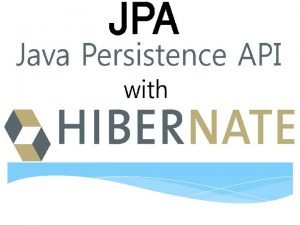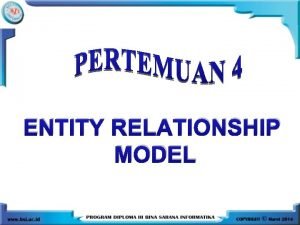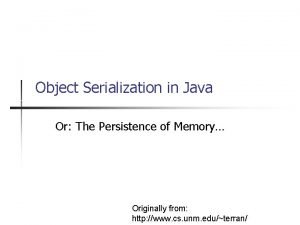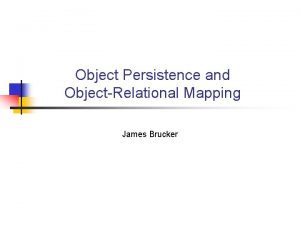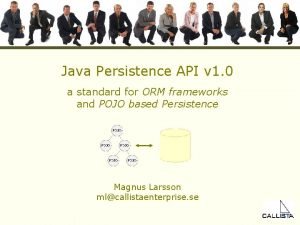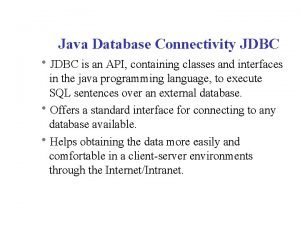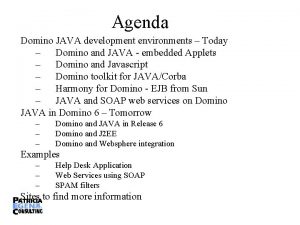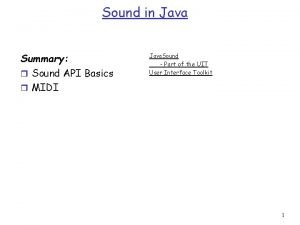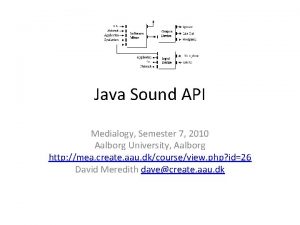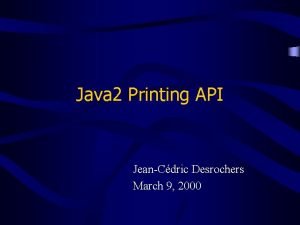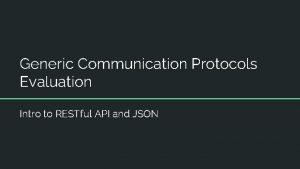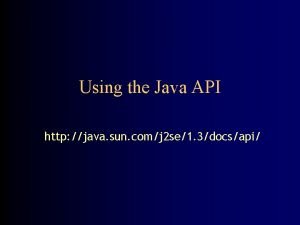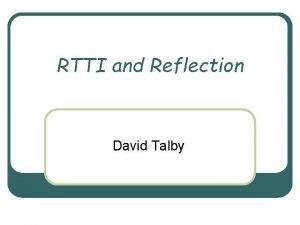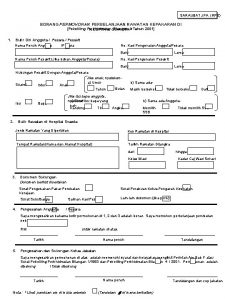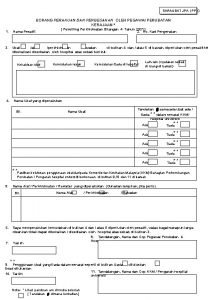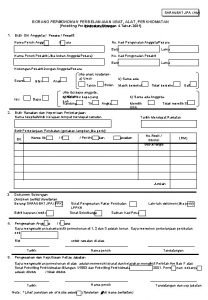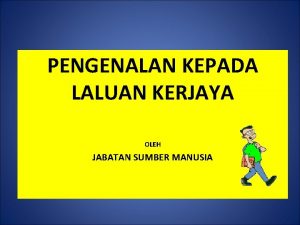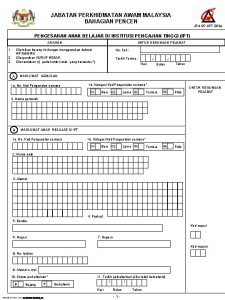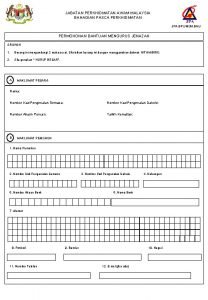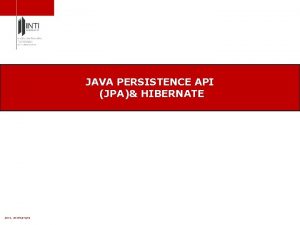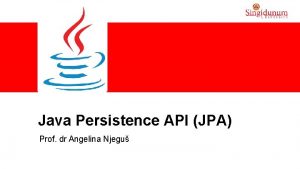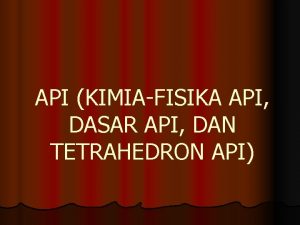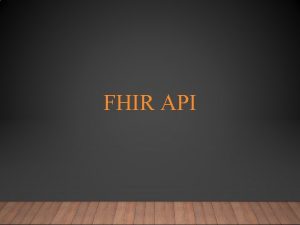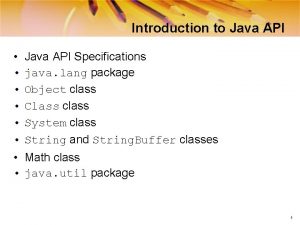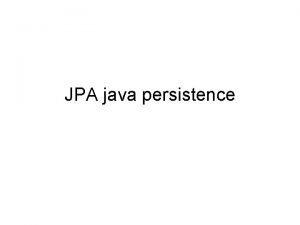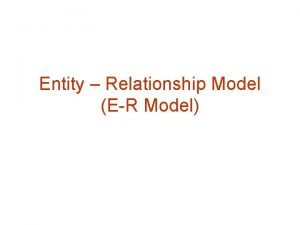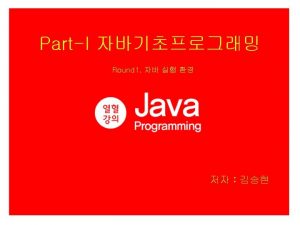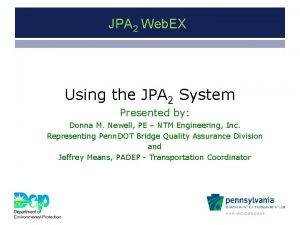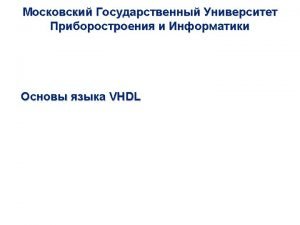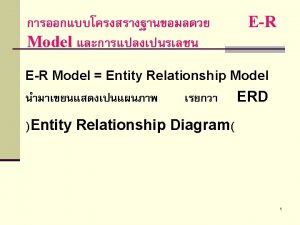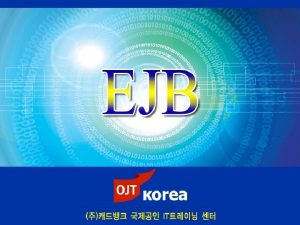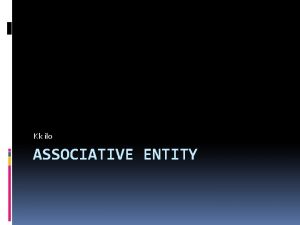JPA JAVA API Specification Entity persistence model for































- Slides: 31


JPA § JAVA API Specification § Entity persistence model for EJB 3. 0 § POJO based framework for Java Persistence § Management of Relational Data in JAVA applications § javax. persistence package § JPA 1. 0 - 11 th May 2006 § JPA 2. 1 - 22 nd April 2013

Benefits of JPA § JDBC was a low level API, It is simple, but error prone § JPA leverages best ideas from ORM community § Developers can choose between different implementations § Vendor Independence

Goals of JPA § Provides complete ORM solution for J 2 SE and J 2 EE applications § Easy to use , no need to implement any framework interfaces or classes § Facilitate test driven development § Annotation Driven, No XML mapping needed

POJO Requirements § Annotated with @Entity § A lightweight persistence domain object § Contains a persistent @Id field § Should be a top level class § class , method or persistent field shouldn’t be final § Represents a table in a relational DB

JPA Annotations § Annotations are from the package javax. persistence § Annotation can be placed either on field or properties § Field level access is preferred to prevent executing logic § property level annotations are applied on getter methods § Can’t mix the style in inheritance hierarchy

Persistent Identifiers § § § Entities must define an id field/fields corresponding to the database primary key The Id can either be simple or composite value Strategies @Id Single valued type –Most common @Id. Class -Maps multiple fields to table PK @Embedded. Id -Map Pk class to table PK Composite primary classes must Implement serializable Override equals() and hash. Code()

@Generated. Value § Supports auto generated primary key value Strategies defined by Generation. Type enum are • Generation. Type. AUTO • Generation. Type. IDENTITY • Generatio. Type. SEQUENCE • Generation. Type. TABLE

Commonly Used Annotations § @Table and @Column Used to define name mappings between java objects and database table or column @Table applied at the persistent class level and @Column applied at the persistent field/property level

Commonly Used Annotations Contd § @Temporal Used with java. uil. Date or java. util. Calendar to determine how value is persisted § Values defined are Temporal. Type. TIME (java. sql. Time) Temporal. Type. DATE (java. sql. Date) Temporal. Type. TIMESTAMP (java. sql. Timestamp)

Commonly Used Annotations Contd § @Enumerated Used to determine the strategy for persisting java enum values to database § Values defined are Enum. Type. ORDINAL Enum. Type. STRING

Commonly Used Annotations Contd § @Transient By default JPA assumes all fields are persistent Non persistent fields should be marked as transient or annotated with @Transient § @Lob Used to persist values to BLOB /CLOB fields Often used with @Basic to lazy load value

JPA Architecture

Entity. Manager. Factory § It gives an application-managed entity manager § An Entity. Manager. Factory can have several Entity Managers § Once an Entity. Manager. Factory is closed, all its entity managers are in the closed state.

Entity. Manager § Handles O/R Mapping of Entities to the database § Provides APIs Ø inserting objects into database Ø fetching objects from database Ø synchronizing objects with database Ø querying database § Provides caching and coordinates transactional services

Persistence Unit § A set of all entity classes managed by Entity. Manager instances. § Defined in META-INF/persistence. xml. § Identified with a unique name.

Entity § A lightweight persistence domain object § Represents a table in a relational DB § Entity class annotated with javax. persistence. Entity § A top level class § Have a unique object identifier

Entity Life Cycle

JPA 2. 1 Vendors JPA

ORM § Converts data between incompatible type systems in object -oriented programming languages. § Creates a "virtual object DB“. § Make RDBMS looks like ODBMS.

Hibernate § A well known ORM tool. § Most popular JPA API implementation. § Maps the Relational Model in the database to the Object Model in Java.

Hibernate Architecture

JPA with Hibernate

CRUD § Persist() § Find() § Merge() § Remove()

Query § Native SQL § JPQL § Criteria Query § Named Query (XML & Annotation)

Query Native SQL Criteria Query JPQL

Associations § One to One § One to Many § Many to One § Many to Many Ø Unidirectional Ø Bidirectional § A unidirectional relationship is valid in only in one direction. It has only an owning side. § A bidirectional relationship is valid in both directions. It has both an owning side and an inverse (non-owning) side.

A B a 1 a 2 a 3 b 1 b 2 b 3 Associations A B b 1 a 1 b 2 a 2 b 3 One to One A b 4 B b 1 a 1 b 2 a 2 b 3 b 4 Many to Many One to Many A B a 1 a 2 a 3 b 1 b 2 Many to one

Demerits of ORM

Thanks!

Questions ? ? ?
 Jpa weak entity
Jpa weak entity Iot design methodology steps
Iot design methodology steps Total participation constraint adalah
Total participation constraint adalah Contoh strong entity
Contoh strong entity Public interest entity
Public interest entity Public interest entity vs listed entity
Public interest entity vs listed entity If lclp is negative number, we set the lclp = 0. why?
If lclp is negative number, we set the lclp = 0. why? Upper specification limit and lower specification limit
Upper specification limit and lower specification limit Object persistence in java
Object persistence in java Object persistence in java
Object persistence in java Site:slidetodoc.com
Site:slidetodoc.com Dali jpa tools
Dali jpa tools Jpql
Jpql Java object persistence
Java object persistence Bian capability model
Bian capability model Sae ams2750
Sae ams2750 Java database connectivity api
Java database connectivity api Dominonappulat
Dominonappulat Java sound api
Java sound api Java sound api
Java sound api Java printer api
Java printer api Java graphics
Java graphics Generic rest api java
Generic rest api java Sun java api
Sun java api Java reflection api
Java reflection api Java reflection api
Java reflection api Borang rps
Borang rps Borang sara ubat jpa am
Borang sara ubat jpa am Saraubat jpa
Saraubat jpa Kenaikan pangkat secara fleksi jpa
Kenaikan pangkat secara fleksi jpa Jpa.bp.spt.b03a
Jpa.bp.spt.b03a Pasca perkhidmatan jpa
Pasca perkhidmatan jpa
